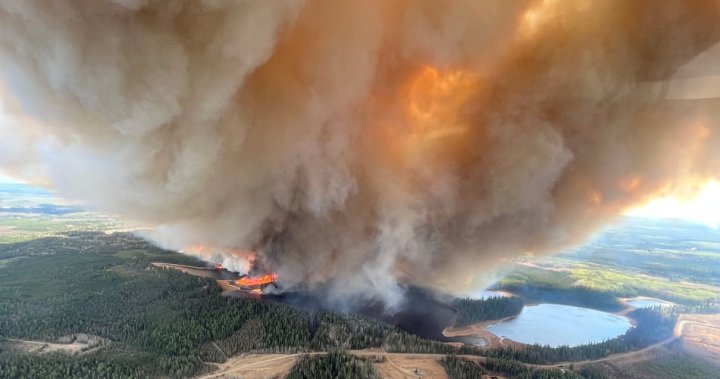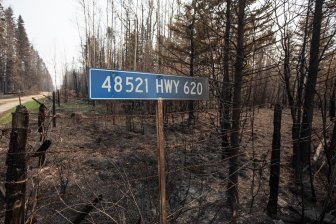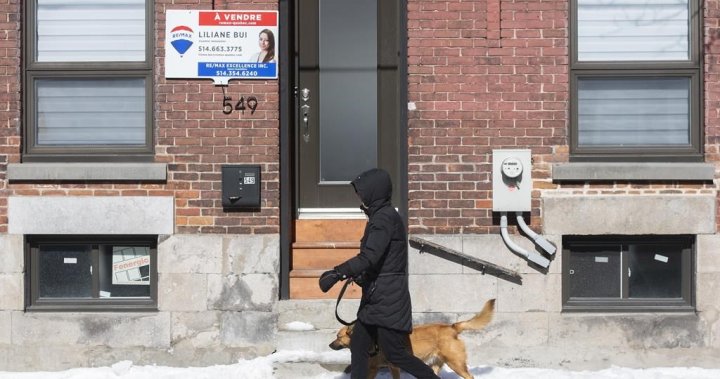The above-seasonal conditions in Alberta have some emergency services on alert as the warm and dry conditions create an increased risk of wildfires and grassfires.
“The warmer and the drier it is, it’s not great for agriculture, it’s not great for the forest fire risk going into the spring,” Environment & Climate Change Canada Warning Preparedness Meteorologist Alysa Pederson said.
The El Nino pattern continues to bring above-seasonal conditions. This flow has also directed storms from British Columbia to push north into the Northwest Territories or south into the United States.
“With the storms and the warm air over us and the storms kind of going north or south of us, they’re generally drier years as well,” Pederson said.
They’re forecasting warmer-than-normal conditions for January and February. She hopes the back half of the winter dumps snow mixed with cooler temperatures to avoid a repeat of last year’s wildfire season.
“Edmonton saw its first 30-degree [Celsius] day of the year on May 3. So we melted our little snowpack we had last year. We melted it very quickly, which then led to the bad fire season this year,” Pederson explained.
“What we can hope for is more snow so that we have a little bit of a prolonged melting,” Pederson added.
Strathcona County Fire said they’ve extinguished a few grassfires this month.
The division isn’t concerned as far as the amount it would spread compared to the spring, but using their mobile units in the middle of winter is unusual.
“We usually get them winterized. The water tank is empty. The fittings might be anti-freezed,” Deputy Chief Operations Dana Terry explained.
“Last year we were -30 [degrees Celsius] over Christmas season. The grassfire trucks were not stocked and ready to go for a grassfire. So, this year is a little bit different with the milder temperatures. We are using those trucks with the tanks full,” the chief continued.
Alberta Wildfire said their predictive services and meteorologists are currently analyzing the lack of precipitation and the dryness level of the leaves and trees.
Get the latest National news.
Sent to your email, every day.
Information Unit Manager Christie Tucker said there is an increased wildfire danger in 2024 from dry conditions before the winter as well.
“Yes, we have a dry winter this year. It’s following a dry fall, a dry summer, and a dry spring for many parts of the province,” she stated.
“Even if we receive an average amount of rainfall in the spring, we are still expecting to see elevated wildfire danger, particularly in the north of the province because of how dry it’s been all year round,” she added.
According to the Alberta Wildfire Status Dashboard, as of Friday afternoon, 64 active wildfires are burning in the province. None are considered out of control.
Tucker said at this time last year, Alberta saw around 15 active wildfires.
“We are going into 2024 with more wildfires burning in the province and we are going to have to monitor them extremely closely, particularly as things dry out,” she mentioned.
The lack of precipitation and melted snowbanks prompted some regions to issue fire restrictions and advisories.
As of Friday, just outside of Edmonton, a fire restriction is active in Parkland County. Fire advisories are also issued in Lac Ste. Anne County, Lamont County, as well as Fort Saskatchewan and the town of Devon.
The organization pleads with residents to follow the rules outlined by municipalities and counties.
“Certainly it is unusual in winter time to be cautioning people not to do their outdoor burning. There are a lot of people in rural areas who wait for the winter to burn off some of the vegetation or trees on their property. We’re asking people in those cases to wait until there’s 15 cm of snow on the ground and do it safely,” Tucker said.
Thompson Rivers University wildland fire professor Mike Flannigan said while it’s odd to discuss wildfires in December, it’s not the first time.
“It makes me think of 1997 and there were fires in December in ’97, so this does happen every so often,” he said.
Environment Canada confirmed 1997 was also an El Nino year.
Flannigan said while concerns are raised, residents must abide by fire bans and restrictions.
Flannigan added nearly half of total wildfires in the province are human-caused.
“Typically in Alberta, it’s close to 50-50. Fifty per cent started by people and their activities and 50 per cent started by lightning. There’s a seasonal effect. Many of the fires in spring are human-caused, and many of the fires in the summer are lightning-caused,” he explained.
“So 2023 was heavily weighted to human-caused. Through education, fire bans, forest closures, I think there are things we can do to reduce the number of fire starts by humans and their activities,” he added.
© 2023 Global News, a division of Corus Entertainment Inc.





